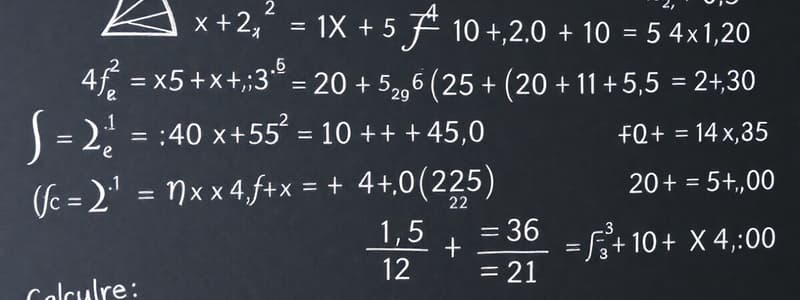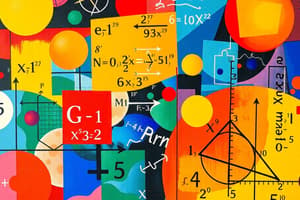Podcast
Questions and Answers
Which branch of mathematics primarily deals with shapes and their properties?
Which branch of mathematics primarily deals with shapes and their properties?
- Calculus
- Algebra
- Geometry (correct)
- Trigonometry
What type of number includes both positive and negative whole numbers?
What type of number includes both positive and negative whole numbers?
- Integers (correct)
- Irrational Numbers
- Rational Numbers
- Natural Numbers
Which operation is performed first according to the order of operations?
Which operation is performed first according to the order of operations?
- Parentheses (correct)
- Addition
- Multiplication
- Subtraction
Which equation type is represented by the formula ax² + bx + c = 0?
Which equation type is represented by the formula ax² + bx + c = 0?
Which branch of mathematics focuses on the analysis of change and motion?
Which branch of mathematics focuses on the analysis of change and motion?
Flashcards are hidden until you start studying
Study Notes
Key Concepts in Mathematics
1. Branches of Mathematics
- Arithmetic: Study of numbers and basic operations (addition, subtraction, multiplication, division).
- Algebra: Involves symbols and letters to represent numbers and quantities in formulas.
- Geometry: Study of shapes, sizes, and properties of space.
- Trigonometry: Focuses on the relationships between the angles and sides of triangles.
- Calculus: Analysis of change and motion; includes differentiation and integration.
- Statistics: Study of data collection, analysis, interpretation, presentation, and organization.
- Discrete Mathematics: Focuses on countable, distinct structures; includes graph theory and combinatorics.
2. Fundamental Concepts
-
Numbers:
- Natural Numbers: Counting numbers (1, 2, 3,...).
- Whole Numbers: Natural numbers plus zero.
- Integers: Whole numbers and their negatives.
- Rational Numbers: Numbers that can be expressed as a fraction (a/b).
- Irrational Numbers: Numbers that cannot be expressed as a fraction (π, √2).
-
Operations:
- Addition (+), Subtraction (−), Multiplication (×), Division (÷).
- Order of Operations: PEMDAS/BODMAS (Parentheses/Brackets, Exponents/Orders, Multiplication and Division, Addition and Subtraction).
3. Equations and Inequalities
- Linear Equations: Equations of the first degree (e.g., y = mx + b).
- Quadratic Equations: Second-degree equations (e.g., ax² + bx + c = 0).
- Inequalities: Statements that describe the relative size or order of two values (>, <, ≥, ≤).
4. Functions
- Definition: A relation that assigns exactly one output for each input.
- Types of Functions:
- Linear: Straight line graphs (y = mx + b).
- Quadratic: Parabolic graphs (y = ax² + bx + c).
- Exponential: Rapidly increasing/decreasing graphs (y = a * b^x).
- Logarithmic: Inverses of exponential functions.
5. Geometry
- Basic Shapes: Circle, Triangle, Rectangle, Square, Polygon.
- Formulas:
- Area:
- Rectangle: A = length × width
- Triangle: A = 1/2 × base × height
- Circle: A = πr²
- Perimeter: Sum of all sides.
- Volume: For 3D objects (e.g., Cylinder: V = πr²h).
- Area:
6. Probability and Statistics
- Probability: Measure of likelihood (P = favorable outcomes / total outcomes).
- Mean, Median, Mode: Measures of central tendency.
- Standard Deviation: Measure of the amount of variation or dispersion of a set of values.
7. Mathematical Reasoning
- Inductive Reasoning: Drawing general conclusions from specific examples.
- Deductive Reasoning: Drawing specific conclusions based on general principles or rules.
8. Mathematical Proofs
- Types: Direct proof, Indirect proof, Contradiction.
- Use of logical steps to establish the truth of a statement.
Study Tips
- Practice regularly with problems.
- Visualize concepts using diagrams and graphs.
- Relate mathematical concepts to real-world applications.
- Use online resources, videos, and math software for additional explanations and practice.
Branches of Mathematics
- Arithmetic deals with numbers and basic calculations like addition, subtraction, multiplication, and division.
- Algebra uses symbols and letters to represent numbers, making it possible to solve equations and represent relationships.
- Geometry explores shapes, their sizes, and how they fit within space.
- Trigonometry focuses on the connection between angles and sides within triangles.
- Calculus analyzes how things change and move. It includes differentiation and integration.
- Statistics involves collecting, analyzing, interpreting, presenting, and organizing data.
- Discrete Mathematics deals with distinct, countable structures, including graph theory and combinatorics.
Fundamental Concepts
- Numbers can be classified into different categories:
- Natural numbers are used for counting (1, 2, 3...)
- Whole numbers include natural numbers and zero.
- Integers include whole numbers and their negative counterparts.
- Rational numbers can be expressed as fractions (a/b).
- Irrational numbers cannot be written as fractions (e.g., π, √2).
- Operations involve basic mathematical actions:
- Addition (+), Subtraction (-), Multiplication (×), Division (÷) are the fundamental operations.
- The order of operations (PEMDAS/BODMAS) dictates the sequence for solving expressions: Parentheses/Brackets, Exponents/Orders, Multiplication and Division (from left to right), Addition and Subtraction (from left to right).
Equations and Inequalities
- Linear equations are first-degree equations (e.g., y = mx + b), representing straight lines when graphed.
- Quadratic equations are second-degree equations (e.g., ax² + bx + c = 0), forming parabolas when graphed.
- Inequalities compare values, expressing relative size or order using symbols like > (greater than), < (less than), ≥ (greater than or equal to), ≤ (less than or equal to).
Studying That Suits You
Use AI to generate personalized quizzes and flashcards to suit your learning preferences.




